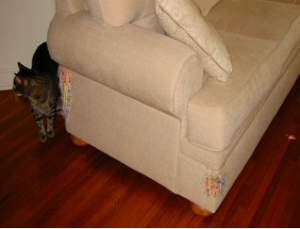Cat claws are a sensitive topic – after all in USA the surgery to remove claws completely is commonly performed. I got a phone call from a lady who moved to Mundaring from USA.
 She had a kitten and it was clawing at her lounge and she asked at what age she could get it de-clawed. Ahhh – actually we don’t do de-clawing surgery in Australia was my reply. However, I think all of us are sympathetic to her feelings of frustration when our cats shred furniture using claws.
She had a kitten and it was clawing at her lounge and she asked at what age she could get it de-clawed. Ahhh – actually we don’t do de-clawing surgery in Australia was my reply. However, I think all of us are sympathetic to her feelings of frustration when our cats shred furniture using claws.
Like us humans, cats tend to be creatures of routine. We can use that to our advantage (which sort of makes up for the cats persistent meowing at 5am in the morning to be let out, knowing us gullible humans will reward that sort of behaviour by ………… doing exactly what they wanted!)
Let’s assume that YOUR cat is scratching at your furniture, and you would like to keep your sanity, your furniture and your cat all in one piece.
Firstly, using punishment (negative reinforcement in behavioural terms) is ineffective as a training tool with cats. It will stop that behaviour for the immediate time, however has been demonstrated to be likely to lead to other behaviours that you really don’t want either (notably urine marking on furniture). By all means distract your cats attention to stop them doing the scratching if they are caught red handed (e.g. make a noise) but don’t take further action that is seen as punishment.
Let’s work with your cats known likes and dislikes – by way of training them to scratch where you want and NOT where you don’t want.
Firstly, cats need access to a scratching post – and to retrain their feline focus where you want it, initially the scratching post must be in the room where your criminal cat is currently scratching at furniture (yes, it can be moved over time to another location).
Teaching your cat to use a scratching post is an article in its own right (if you want that article, just say and happy to write that). However, the scratching post needs to be at the centre of their universe. Ignore giving your cat attention unless it is near or around the scratching post. They will start to associate good things happening (cats really DO like your attention) with that scratching post. This includes playing with your cat – in fact their toys that they enjoy using should be on or around that scratching post.
Over a period of days – your cat will start to learn that that scratching post really makes things happen.
They will, of course, sooner or later use it to scratch. That is when you praise and reward that behaviour, with a treat that you know they will enjoy (could be Catnip, small easily eaten treats, petting attention) – you know your cat best as to what they enjoy. Now – cats aren’t as easily fooled into changing behaviours as quickly as dogs, but be assured that persistence on your behalf WILL pay off. They learn that scratching at that post leads to good things. This is not a permanent need to reward the behaviour – it will become self-rewarding and self-sustaining with time.
At the same time as you are going to make that scratching post accessible and a really positive part of their life, you need to booby-trap the furniture that they are scratching at. Again – your cat will need an individualised approach however booby traps can consist of one or more of the following:
- Cover the furniture you wish to focus on with cloth (such as a towel), using scent of oil such as eucalyptus, menthol or citrus that cats don’t really like.
- Use an open weave cloth such as cheesecloth – as cats HATE getting their claws stuck in things and will start viewing that furniture with a new sense of suspicion.
- Use aluminium can (with pebbles or marbles in it) or bells on top of the cloth, with string looped over outside of the cloth. Our cat culprit will tend to catch the string as part of the scratching motion, bringing the can/bells down with it. This jangling noise is enough to make the cat pretty unhappy with this result, and the furniture becomes a much less attractive area to go in search of scratching Nirvana.
Now, as you are already aware that our cats like routine – ideally the scratching post goes where the furniture was (so the location is consistent) and the furniture is moved elsewhere in that room. That isn’t always practical or possible – however at least now you are thinking like a cat to take advantage of their desire for familiarity and routine.
Over time, the scratching post can be moved gradually towards where you DO want this to be in the room. There is an amazing array of really cool looking scratching post available these days, so it is quite possible to get a scratching post that makes both your sense of interior design and your cat mutually happy.
The length of time that is going to be taken to re-train your cats scratching habits is of course dependent on how long it has been scratching at furniture to this point, and how consistent you can be in positively reinforcing your cats new scratching post behaviour and booby trapping the furniture in question. Broadly the answer is going to be a couple of weeks. The more you create a situation that makes sense to your cat’s way of thinking, the smoother your transition to both you and your cat getting what you both need.


